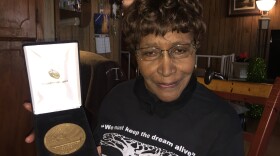Alabama Public Radio is turning 40 years old. All year long the APR news team is diving into the archive to bring you the best of the best of our coverage. That includes this story from 2014. The APR newsroom spent six months digging into the history of the 150th anniversary of the Battle of Mobile Bay. That includes this family story that’s set in Alabama, but not about soldiers fighting for the Confederacy.
The sound of cannon fire was music to the ears of hundreds of Civil War buffs. They all braved the rain on this wet, muddy Saturday near the town of Resaca, Georgia just over the border from Northeast Alabama.
“What’s kind of neat is that this re-enactment is taking place on part of the actual battle ground," said Ken Padgett.
The Georgia native is acting as the General of today’s re-enactment. During the real battle in 1864, Confederate General Joe Johnston faced General William T. Sherman from the North.

“Resaca was basically a draw between the two armies. But with the Federals’ superior numbers, they outflanked the Confederate army and crossed the rivers downstream and threatened to cut off the Confederate retreat. So, they had to pull back in the middle of the night," Padgett said.
One unit that took place in the actual battle was a rag tag group from Madison County called the 1st Alabama Cavalry. It’s OK if you’ve never heard of them. Historians have.
“Actually, they did a lot,” said Doctor John Kvach.
He teaches history at the University of Alabama in Huntsville, not far from where the First Alabama Calvary first formed.
“They served and they fought and they died, and they sacrificed just like every other unit that was fighting throughout the war," Kvach said.

But, this is where the story gets a little complicated. During the Presidential election of 1860, not everybody in Alabama liked slavery or the thought of the South breaking away from the Union. Kvach said that left the men of the 1st Alabama Cavalry in a bind on election day.
“You might be voting for your very own destruction by voting for secession. Yet, you’re also voting for how you feel about the direction of your party, your country, and the future of your family," he said. "So, for many people, this was a very, very difficult decision.”
And, that decision may have raised eyebrows in Alabama in 1860.
“Their convictions pushed them toward supporting the Union, by becoming part of the Union forces. They fought a number of skirmishes and major battles, and in fact became a guard for General William T. Sherman," Kvach said.

“Sherman is a bad word around Alabama. He’s not one of our favorites," said Sallie Cox of Birmingham.
She found out about the 1st Alabama Cavalry while researching her family tree. “marriage certificate FX” Judging from the pile of documents on her dining room table, Cox has been keeping busy. She wanted to qualify to join the Daughters of the American Revolution. After a little digging, she found something a little different. Namely, Captain Fernando Cortez Burdick of the 1st Alabama Cavalry. He went by Frank.
“Great. Great…I think it’s two greats. Grandmother…..yeah, it’s great great grandfather, right,” Cox said.
Cox considers herself an Alabamian, even though she was born in Tennessee. She does have relatives up north, and when word got out that one of her ancestors fought for the Union.
“Nobody up there seem to think it’s all that odd. Frankly, I do," Cox said.
The fact that Frank Burdick was a Southerner who fought for the Union doesn’t bother historians like Kvach. What does bug him are the stereotypes about the North and South that can make stories like Burdick’s such a novelty.
“What I tell my students is that history isn’t black or white, it’s gray,” Kvach said.
But, getting that idea across has been an uphill climb. Kvach said most people think of the North in the 1860’s as industrial and the South as a bunch of wealthy plantation owners sipping mint juleps. Kvach said that’s bunk popularized by books like “Gone With The Wind.”
“In 1860, if taken as a separate nation, the South was the fifth most industrialized nation in the world," Kvach said.
The one thing everyone seems to agree on is how war pitted brother against brother. Padgett's hobby of being in charge with the re-enactment of the battle of Resaca has helped turn him into an amateur historian. Padgett said he heard a lot of stories across the South similar to the 1st Alabama Cavalry.

“And you had relatives who were loyal to the Union, and those who were rebellious and were loyal to the Confederacy. So it was not uncommon for soldiers on both sides to come across some of their wounded relatives on the field," Padgett.
And that idea hits close to home for Sallie Cox. There’s a portrait that hangs on the wall in her dining room. It’s a painting of two men, one in Union blue and the other in gray.
“This is Fernando Cortez Burdick, and the other is Robert Alexander Hill. Their children married. His son married his daughter. These are my great great grand parents," said Cox.
And it should come as no surprise that while Burdick fought for the Union, Hill was for the Confederacy.
“The thing that I thought was so interesting what that both of them was at the battle of Shiloh, and we always joke in the family that great great grandpa Burdick shot great great grandparent Hill, which didn’t happen, but it makes a great story," Cox said.
Cox admits if he had, she wouldn’t be here as their descendent. Burdick and Hill returned to Madison County after the war to form Cox’s branch of the family tree. So, it appears everything was resolved.
“I consider myself Southern. I’m no Yankee.”











